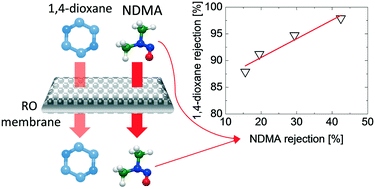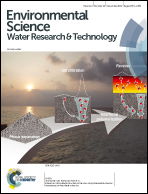Online monitoring of N-nitrosodimethylamine for the removal assurance of 1,4-dioxane and other trace organic compounds by reverse osmosis†
Abstract
Public health protection and cost effectiveness of potable reuse can be improved by providing reliable water quality assurance for removal of trace organic compounds (TOrCs) by reverse osmosis (RO) membranes. This study evaluated the effectiveness of online monitoring of N-nitrosodimethylamine (NDMA) removal using a RO system to ensure the removal of low molecular weight TOrCs. Among the 51 TOrCs selected in this study, a major focus was placed on 1,4-dioxane due to the limited information on the removal of 1,4-dioxane by RO. Laboratory-scale experiments showed that the rejection of 1,4-dioxane by two commercial RO membranes—ESPA2 and HYDRA (98 and 99%, respectively)—was higher than that of NDMA (57 and 81%, respectively). Pilot-scale experiments using treated wastewater identified a strong linear correlation between 1,4-dioxane and NDMA rejection over a range of feed temperature. The pilot-scale results also demonstrated the applicability of NDMA as a conservative performance indicator for 46 other TOrCs at two different RO feed temperatures. These results suggest that online monitoring of NDMA in RO feed and permeate can allow for ensuring the removal of larger TOrCs, which could provide additional protection of public health in potable reuse.



 Please wait while we load your content...
Please wait while we load your content...